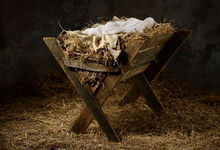Opening our hearts to welcome Jesus
A stable, a manger, an ox, and a donkey—this is how we picture the night that changed everything. But wait a minute: two of three components in the nativity scene don’t even belong there. The question is therefore very important: do you recognise the sign?

They arrived in the nick of time. She was about to go into labour and they still had not found a place to stay. This being an emergency, a stable would have to do. Here is where the Light of the World first saw the light of day. Interestingly, neither Matthew nor Luke mention a stable.
Neither is the cave documented, which the Orthodox Church uses instead. The idea of an ox and a donkey are improbable: it was borrowed from Isaiah. This is where the so-called Gospel of Pseudo-Matthew took it from—one of the many later writings that sought to fill in the narrative gaps left by Scripture.
As a matter of fact, biblical scholars assume that Jesus was born in a traditional peasant house: in a lower room, where animals were otherwise kept, presumably because the guest room in the house was already occupied.
So does the Christmas story have to be rewritten?
He wanted to be very close
No, because the decisive sign remains unchanged. In fact, this knowledge puts a greater focus on it. The Bible itself calls it a sign: “And this will be the sign to you: you will find a Babe wrapped in swaddling cloths, lying in a manger” (Luke 2: 12).
Wrapping a child in swaddling cloths was not unusual at the time. But what does the manger, this makeshift crib, have to tell us?
God became man, but not just like that and anywhere. He who would later be glorified, began His life in extreme poverty. He who would later ascend to the Father in heaven, began at the very bottom, in the middle of the worries of daily life. The Saviour wanted to be very close to mankind.
Anything but a coincidence
Anyone who looks closely can detect even more in the image of the manger. The angels delivered the glad tidings—the message of the birth of the Saviour—only to a very specific group of people: the shepherds. Was this a coincidence? Well, they were still awake … Nothing of the sort!
No occupation was as despised as that of a shepherd, Rabbinic literature tells us. In the eyes of the Pharisees, shepherds were unclean because they could not keep the laws of purification as they should have. They were considered to be am ha'aretz, which is Hebrew for “people of the land”, likewise the tax-collectors.
Come back every time
And that has a lot to tell us. Jesus Christ did not go to the rich, the powerful, and the perfect first. He came to the poor, the helpless, and the rejected. From his first breath in humble circumstances to his last breath in painful humiliation, He shared life with those whom He wanted to save—with all its consequences. This throws a very special light on the words of God recorded in Isaiah 57: 15: “For thus says the High and Lofty One who inhabits eternity, whose name is Holy: ‘I dwell in the high and holy place, with him who has a contrite and humble spirit, to revive the spirit of the humble, and to revive the heart of the contrite ones.’”
Jesus wants to come into the middle of our lives, our very personal daily reality, every day anew. And one day, He will return one final time in His full glory. Let us welcome Him as the shepherds did. Let us hear and see Him, and feel awe and wonder. And let us tell others about Him and what we experience with Him.
Photo: Elena Schweitzer - stock.adobe.com
Article info
Author:
Date:
Andreas Rother
25.12.2018













